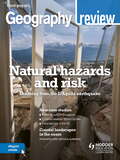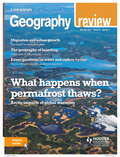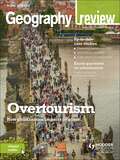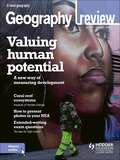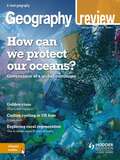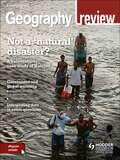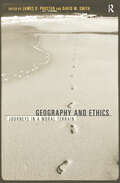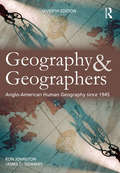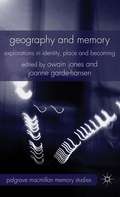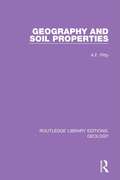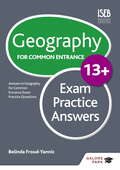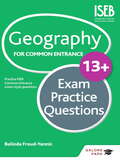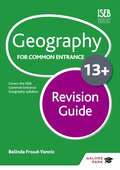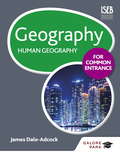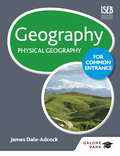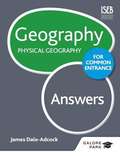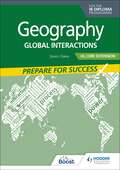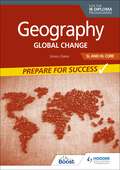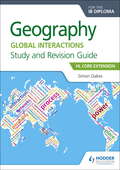- Table View
- List View
Geography Review Magazine Volume 32, 2018/19 Issue 1
by Hodder Education MagazinesThis A-level geography magazine provides topical articles by experts in the field, specifically written for students to help them gain the highest grades. With up-to-date articles and case studies, it also includes advice on the NEA and approaching exam questions.ContentsHazard perception and risk: learning from the L'Aquila earthquake Noel Castree Question and answer Coastal landscapes and change Geographical ideas Representation David Redfern Achieving water security: a case study of Singapore Yvonne Follows-Smith Everybody's talking about... Premature deindustrialisation Simon Oakes Centrepiece Life expectancy in England: a north-south journey Clare Bambra and Chris Orton Storm Ophelia: a UK case study of extreme weather Sylvia Knight NEA ideas Researching inequality Martin Evans Global governance Getting to grips with global norms Simon Oakes Do food banks help? Food insecurity in the UK Jon May, Andrew Williams, Paul Cloke and Liev Cherry El Niño and La Niña: understanding extreme weather George Adamson Geographical skills How to use qualitative data: researching place with images and oral histories David Holmes The big picture The death of the Arctic? Jamie Woodward
Geography Review Magazine Volume 32, 2018/19 Issue 2
by Hodder Education MagazinesContents:Australia's migrants: impacts on urban growthIain MeyerQuestion and answerWater and carbon cyclesThe permafrost carbon feedback: the impact of global warming on Arctic ecosystemsPhilip WookeyThe equality of water supply in Lilongwe: a resource-security case studyNoel CastreeCentrepieceEarth's changing climateEd HawkinsAdapting to climate change: an agricultural case study from Nepal Mary Peart and Morgan PhillipsGlobal development update Modern slavery: an issue of global governanceGill MillerGeographical ideasInequalitySimon OakesThe geography of branding: using place to sell productsAndy PikeGeographical skillsHow to use qualitative data: researching place with interviews and social mediaDavid HolmesNEA ideasResearching place and brandingMartin EvansThe big pictureWhy are Africa's oldest baobabs dying?Jamie Woodward
Geography Review Magazine Volume 32, 2018/19 Issue 3
by Hodder Education MagazinesContents for this issue:Changing the meaning of place: a rebranding case study of Park Hill Flats, SheffieldQuestion and answerGlobal urbanisationEverybody's talking about...OvertourismRiver ecosystems: why do they matter?Geographical ideasCausalityCentrepieceWorlds of wealthMeasuring diversity of place: a case study of LondonThe global e-waste tradeCarbon updateGreenhouse gases: monitoring for mitigationWater security across borders: two international case studiesGeographical skillsUsing photos as evidence in your NEA: getting the picture rightNEA ideasChanging placesThe big pictureCan we tackle the ocean plastics problem?
Geography Review Magazine Volume 32, 2018/19 Issue 4
by Hodder Education MagazinesContents for this issue: Coral reef ecosystems: monitoring climate changeQuestion and answerExtended writing: ten tips for quality answersWhat happens to your rubbish? The geography of wasteFood security in Detroit: a case studyNEA ideas?Measuring surface roughness in natural systemsGeographical ideasInterdependenceCentrepieceCan London become a National Park?Geographical skillsUsing photos as evidence in your NEA: presenting and interpreting imagesWetlands in drylands: understanding dynamic environmentsGlobal development updateInternational trade: changing approachesMaking connectionsGlaciation, climate change and tectonic hazardsMeasuring development: can we improve on GDP?Index to Volume 21The big pictureDestroying the sense of place in Venice
Geography Review Magazine Volume 33, 2019/20 Issue 1
by Hodder Education MagazinesContents: Managing the world's oceans Clive Schofield and Noel Castree Question and answer Regeneration and deprivation Making connections Hazard and place David Redfern Golden visas: how elite migration works David Ley Everybody's talking about 5G Simon Oakes Global development update Changing gender equality Alice Evans Centrepiece Protecting the high seas Olive Hefferman Floodplain fens: a case study of carbon cycling Kate Heppell et al. Carbon update Global temperature targets: do they work? Noel Castree Platform capitalism and globalisation Daniel Whittall Glaciated limestone landscapes: landforms and processes Jamie Woodward and Philip Hughes Geographical skills Researching literature for your NEA David Holmes and Matt Smith NEA ideas Hazard and place Martin Evans The big picture Restoring peatlands as a carbon store Martin Evans
Geography Review Magazine Volume 33, 2019/20 Issue 2
by Hodder Education MagazinesContents:Human vulnerability to 'natural' disasters: a case study of Hurricane KatrinaChristine EriksenQuestion and answerWhy have I been given this? Ten tips to improve data interpretationHow can we manage global warming?Noel Castree and Rob BellamyMaking connectionsLandscapes, climate and diseaseDavid RedfernGeography worksFrom geography degree to NHS managementSir Andrew DillonCarbon updateCarbon in the river systemClaire GoulsbraCentrepieceThe Hong Kong-Zhuhai-Macau megabridgeOllie DaviesRestoring peatlands: can increasing a carbon store help us manage floods?Martin EvansGlobal trade patterns: how are they changing?Jessie PoonGlobal governance updateScales of governance: climate policy in the USASimon OakesAge segregation and place: social inequality in the UKAlbert SabaterGeographical skillsGetting your sampling rightDavid HolmesNEA ideasAge segregationMartin EvansThe big pictureAgriculture and water pollutionNoel Castree
Geography and Ethics: Journeys in a Moral Terrain
by David M. Smith James D. ProctorThis book represents a landmark exploration of the common terrain of geography and ethics. Drawing together specially commissioned contributions from distinguished geographers across the UK, North America and Australasia, the place of geography in ethics and of ethics in geography is examined through wide-ranging, thematic chapters.Geography and Ethics is divided into four sections for discussion and exploration of ideas: Ethics and Space; Ethics and Place; Ethics and Nature and Ethics and knowledge, all of which point to the rich interplay between geography and moral philosophy or ethics.
Geography and Geographers: Anglo-American human geography since 1945
by Ron Johnston James D. SidawayGeography and Geographers continues to be the most comprehensive and up-to-date overview of human geography available. It provides a survey of the major debates, key thinkers and schools of thought in the English-speaking world, setting them within the context of economic, social, cultural, political and intellectual changes. It is essential reading for all undergraduate geography students.It draws on a wide reading of the geographical literature and addresses the ways geography and its history are understood and the debates among geographers regarding what the discipline should study and how.This extensively updated seventh edition offers a thoroughly contemporary perspective on human geography for new and more experienced students alike.
Geography and Memory
by Owain Jones Joanne Garde-HansenThis collection shifts the focus from collective memory to individual memory, by incorporating new performative approaches to identity, place and becoming. Drawing upon cultural geography, the book provides an accessible framework to approach key aspects of memory, remembering, archives, commemoration and forgetting in modern societies.
Geography and Soil Properties (Routledge Library Editions: Geology #9)
by A.F. PittyThis book, first published in 1978, provides a comprehensive guide to soil properties in any major world region. It emphasizes the significance of the spatial changes in soil patterns, the environmental influence on soils, and their temporal changes, but focuses attention on the systematic examination of soil properties and their reciprocal effects. It covers such important topics as the mineral composition of different soils, their organic matter, structure and porosity, chemical make-up and mechanical properties.
Geography for Common Entrance 13+ Exam Practice Answers
by Belinda Froud-YannicThe Geography for Common Entrance at 13+ Practice Exercises Answer Book contains mark schemes and extensive guidance for answering the questions in Geography for Common Entrance at 13+ Practice Exercises. This book contains answers to all questions featured in the accompanying title Geography for Common Entrance 13+ Exam Practice Questions. - Endorsed by ISEB - Provides advice and guidance for achieving top marks - Features worked examples of answers - Includes ISEB Common Entrance mark scheme Suitable for all ISEB 13+ Geography exams taken from Autumn 2015 onwards. Also available from Galore Park www.galorepark.co.uk - Geography for Common Entrance 13+ Exam Practice Questions - Geography for Common Entrance 13+ Revision Guide - Geography for Common Entrance: Physical Geography - Geography for Common Entrance: Physical Geography Answers - Geography for Common Entrance: Human Geography - Geography for Common Entrance: Human Geography Answers
Geography for Common Entrance 13+ Exam Practice Answers (for the June 2022 exams)
by Belinda Froud-YannicPlease note, this resource is suitable for the exams up to June 2022. New revision resources will be available from Spring 2022 for the exams from November 2022.Exam Board: ISEBLevel: 13+Subject: GeographyFirst Exam: Autumn 2015The Geography for Common Entrance at 13+ Practice Exercises Answer Book contains mark schemes and extensive guidance for answering the questions in Geography for Common Entrance at 13+ Practice Exercises. This book contains answers to all questions featured in the accompanying title Geography for Common Entrance 13+ Exam Practice Questions.- Endorsed by ISEB- Provides advice and guidance for achieving top marks- Features worked examples of answers- Includes ISEB Common Entrance mark schemeAlso available from Galore Park www.galorepark.co.uk- Geography for Common Entrance 13+ Exam Practice Questions- Geography for Common Entrance 13+ Revision Guide
Geography for Common Entrance 13+ Exam Practice Questions
by Belinda Froud-YannicIdeal for pupils preparing for Common Entrance and other entrance exams at 13+, or those looking for lots of Geography practice to help hone their skills. This book contains a wealth of practice questions based on the new Geography ISEB Common Entrance exam. The questions are arranged by topic, allowing pupils to practise both key areas of the syllabus and to familiarise themselves with the format of the exam. - Suitable for all ISEB Geography 13+ Common Entrance exams taken from Autumn 2015 onwards - Endorsed by ISEB - Ideal for pupils working towards Geography Common Entrance and entrance exams at 13+ - Features a range of rigorous exam-style Geography exercises for varied practice across all topics - Familiarises pupils with the format of the questions to improve exam technique An Answer Book is also available to accompany this title. Also available from Galore Park www.galorepark.co.uk - Geography for Common Entrance 13+ Exam Practice Answers - Geography for Common Entrance 13+ Revision Guide - Geography for Common Entrance: Physical Geography - Geography for Common Entrance: Physical Geography Answers - Geography for Common Entrance: Human Geography - Geography for Common Entrance: Human Geography Answers
Geography for Common Entrance 13+ Exam Practice Questions (for the June 2022 exams)
by Belinda Froud-YannicPlease note, this resource is suitable for the exams up to June 2022. New revision resources will be available from Spring 2022 for the exams from November 2022.Exam Board: ISEBLevel: 13+Subject: GeographyFirst Exam: Autumn 2015Ideal for pupils preparing for Common Entrance and other entrance exams at 13+, or those looking for lots of Geography practice to help hone their skills. This book contains a wealth of practice questions based on the new Geography ISEB Common Entrance exam. The questions are arranged by topic, allowing pupils to practise both key areas of the syllabus and to familiarise themselves with the format of the exam.- Suitable for all ISEB Geography 13+ Common Entrance exams taken from Autumn 2015 onwards- Endorsed by ISEB- Ideal for pupils working towards Geography Common Entrance and entrance exams at 13+- Features a range of rigorous exam-style Geography exercises for varied practice across all topics- Familiarises pupils with the format of the questions to improve exam techniqueAn Answer Book is also available to accompany this title.
Geography for Common Entrance 13+ Revision Guide
by Belinda Froud-YannicThis book provides ideal preparation for Geography Common Entrance and other entrance examinations at 13+. Geography for Common Entrance 13+ Revision Guide reflects the style and content of the new ISEB Common Entrance syllabus and provides essential support and guidance for thorough exam preparation. - Suitable for all ISEB 13+ Geography exams taken from Autumn 2015 onwards - Endorsed by ISEB - Consolidates all key information required for Common Entrance - Features well-annotated illustration to help convey points - Includes tips, advice and exam-style questions for focused revision - Helps pupils perfect their exam technique and identify any areas requiring further study Also available from Galore Park www.galorepark.co.uk - Geography for Common Entrance 13+ Exam Practice Questions - Geography for Common Entrance 13+ Exam Practice Answers - Geography for Common Entrance: Physical Geography - Geography for Common Entrance: Physical Geography Answers - Geography for Common Entrance: Human Geography - Geography for Common Entrance: Human Geography Answers
Geography for Common Entrance 13+ Revision Guide (for the June 2022 exams)
by Belinda Froud-YannicPlease note, this resource is suitable for the exams up to June 2022. New revision resources will be available from Spring 2022 for the exams from November 2022.Exam Board: ISEBLevel: 13+Subject: GeographyFirst Exam: Autumn 2015This book provides ideal preparation for Geography Common Entrance and other entrance examinations at 13+.Geography for Common Entrance 13+ Revision Guide reflects the style and content of the new ISEB Common Entrance syllabus and provides essential support and guidance for thorough exam preparation.- Suitable for all ISEB 13+ Geography exams taken from Autumn 2015 onwards- Endorsed by ISEB- Consolidates all key information required for Common Entrance- Features well-annotated illustration to help convey points- Includes tips, advice and exam-style questions for focused revision- Helps pupils perfect their exam technique and identify any areas requiring further studyAlso available from Galore Park www.galorepark.co.uk- Geography for Common Entrance 13+ Exam Practice Questions- Geography for Common Entrance 13+ Exam Practice Answers
Geography for Common Entrance: Human Geography
by James Dale-AdcockThe Geography for Common Entrance: Human Geography is fully updated in line with the current 2014 Common Entrance syllabus, and covers everything pupils need to know for Geography Common Entrance and other entrance exams at 13+. The book covers landform processes, settlement, weather and climate and map and fieldwork to ensure pupils develop the important practical skills required at this level. This new edition also features updated thematic studies and a revised 'location knowledge' section to reflect current exam requirements. Geography for Common Entrance: Human Geography Key Benefits: - Fully updated in line with the 2014 Geography syllabus - An ideal resource for pupils working towards Common Entrance and other entrance exams at 13+, or those looking for a stretching Key Stage 3 Geography course - Features updated thematic studies and a revised 'Location Knowledge' section to ensure pupils are learning relevant material - Provides a thorough and comprehensive introduction to map and fieldwork skills so that pupils develop practical Geography skills. Suitable for all ISEB Geography 13+ Common Entrance exams taken from Autumn 2015 onwards.
Geography for Common Entrance: Physical Geography
by James Dale-AdcockThis Geography for Common Entrance: Physical Geography ISEB-endorsed textbook provides a thorough and comprehensive introduction to mapwork and fieldwork skills, as well as covering environmental issues, tectonic processes, economic activities, and location knowledge. Featuring clear explanations throughout, it also contains exercises to challenge pupils of all abilities. This book is an ideal companion for Key Stage 3 Geography. Geography for Common Entrance: Physical Geography Key Benefits: - Features detailed explanations followed by practice questions and extension exercises to ensure that pupils have understood the material covered - Provides a comprehensive introduction to mapwork and fieldwork skills so that pupils develop practical geography skills - Strong emphasis is placed on thematic studies in line with Common Entrance and Common Academic Scholarship requirements to ensure that pupils are learning the most up to date topics. Suitable for all ISEB Geography 13+ Common Entrance exams taken from Autumn 2015 onwards.
Geography for Common Entrance: Physical Geography Answers
by James Dale-AdcockGeography for Common Entrance: Physical Geography Answers features the complete set of answers to the exercises in Geography for Common Entrance: Physical Geography to save you time marking work, and enable you to identify areas requiring further attention. Includes diagrams and workings where necessary, to ensure pupils understand how to present their answers. Suitable for all ISEB Geography 13+ Common Entrance exams taken from Autumn 2015 onwards.
Geography for Life: National Geography Standards, 1994
by Richard G. Boehm Sarah W. Bednarz Norman C. Bettis Roger M. DownsThe inclusion of geography as a core subject in Goals 2000: Educate America Act (Public Law 103-227) is the culmination of a decade of reform in geography education. There is now a widespread acceptance among the people of the United States that being literate in geography is essential if students are to leave school equipped to earn a decent living, enjoy the richness of life, and participate responsibly in local, national, and international affairs.
Geography for the IB Diploma HL Core Extension: Global interactions
by Simon OakesSupport your students to achieve their best grade with the ultimate course companion; providing clear and concise explanations of all syllabus requirements, with exam practice questions to check understanding and consolidate revision. - Fully prepare for the final assessment with examiner advice on how to approach and explore each topic, including additional top tips and common mistakes. - Practice and revise effectively from a range of strategies and a variety of high achieving example answers. - Focus revision by using key terms with definitions listed for each topic and subtopic of the course.- Answers available to download for free: www.hoddereducation.co.uk/ib-extras
Geography for the IB Diploma HL Core Extension: Global interactions
by Simon OakesSupport your students to achieve their best grade with the ultimate course companion; providing clear and concise explanations of all syllabus requirements, with exam practice questions to check understanding and consolidate revision. - Fully prepare for the final assessment with examiner advice on how to approach and explore each topic, including additional top tips and common mistakes. - Practice and revise effectively from a range of strategies and a variety of high achieving example answers. - Focus revision by using key terms with definitions listed for each topic and subtopic of the course.- Answers available to download for free: www.hoddereducation.co.uk/ib-extras
Geography for the IB Diploma SL and HL Core: Global change
by Simon OakesSupport your students to achieve their best grade with the ultimate course companion; providing clear and concise explanations of all syllabus requirements, with exam practice questions to check understanding and consolidate revision. - Fully prepare for the final assessment with examiner advice on how to approach and explore each topic, including additional top tips and common mistakes. - Practice and revise effectively from a range of strategies and a variety of high achieving example answers. - Focus revision by using key terms with definitions listed for each topic and subtopic of the course.- Answers available to download for free: www.hoddereducation.co.uk/ib-extras
Geography for the IB Diploma SL and HL Core: Global change
by Simon OakesSupport your students to achieve their best grade with the ultimate course companion; providing clear and concise explanations of all syllabus requirements, with exam practice questions to check understanding and consolidate revision. - Fully prepare for the final assessment with examiner advice on how to approach and explore each topic, including additional top tips and common mistakes. - Practice and revise effectively from a range of strategies and a variety of high achieving example answers. - Focus revision by using key terms with definitions listed for each topic and subtopic of the course.- Answers available to download for free: www.hoddereducation.co.uk/ib-extras
Geography for the IB Diploma Study and Revision Guide HL Core Extension: HL Core Extension
by Simon OakesStretch your students to achieve their best grade with these year round course companions; provides comprehensive content on all topics, and practice questions to support and strengthen learning. - Develop understanding and knowledge with clear and concise coverage of the syllabus- Target learning with individual books for Standard and Higher level- Consolidate revision and check understanding with a range of exam practice questions- Practise exam technique with tips from examiners throughout on how to tackle questions- Focus revision with key terms and definitions listed for each topic/sub topicAnswers are free online at www.hoddereducation.com/ibextras
